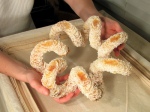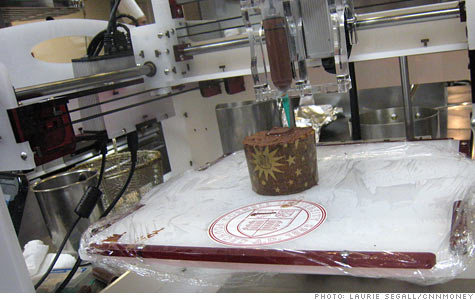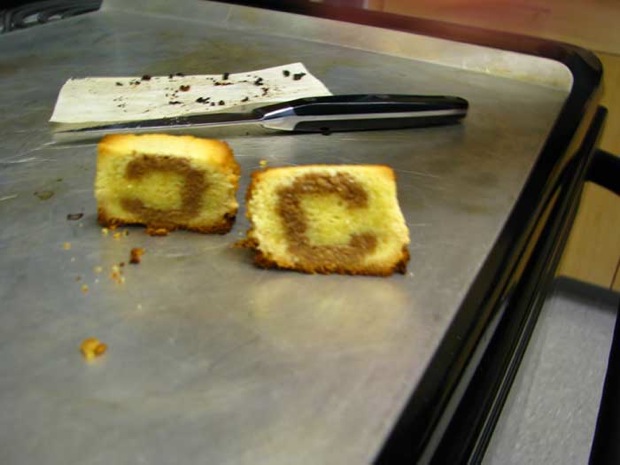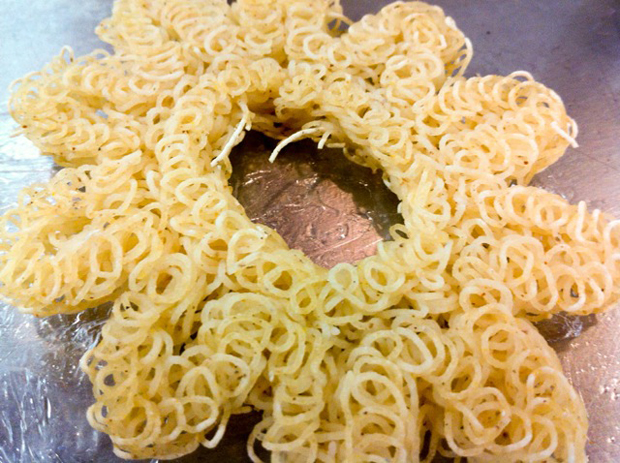
Tuesday, February 28, 2012
Failure of 3D scanning .............
During last couple of weeks I tried to scan marchmellows, but it keeps failing.
All scanned images are broken or separated piece by pice.
Disaster!!!
All scanned images are broken or separated piece by pice.
Disaster!!!
Candy Fab - 3D Print Candy

In 3D printing, objects are built from the bottom up, cross section by cross section, the same way you’re supposed to envision the pieces when you calculate volumes by slicing. This article in the Christian Science Monitor last week likens it to building with legos, although my experience with legos is that separate sections are constructed and then put together (you build the walls, then add the furniture, then the roof); that concept might work with printing too, where you print separate components and then put them together. And what’s amazing is that you can print some pretty complicated things with moving parts.
So what is used for the printing? The article above describes a layer of powder being put down and the printing is actually done by spraying glue instead of ink. Wikipedia also describes printers that build with a liquid gel. But my favorite is printing done with candy.
That’s right: candy. Not surprisingly, the CandyFab 6000 and it’s earlier prototypes are made by the folk at Evil Mad Scientist Laboratories. Here’s an example of 3D printing:


You can see it making some 3D Candy above. They keep making improvements, as you can see in the two dodecahedrons below (printed at different times):


eight pounds of sugar!!!!

Now that’s some pretty neat printing. You can even see the “slices” on the surface.
All photos are licensed under Creative Commons; the photos link to their home on Flickr, and you can find even more here, plus more information here.
Research: Food Printing 3

An experimental 3D food printer "prints" frosting on a cupcake.
http://money.cnn.com/2011/01/24/technology/3D_food_printer/index.htm
Research: Laser Cut Paper "2D to 3D"
http://www.stumbleupon.com/su/706fPs/www.fastcompany.com/blog/cliff-kuang/design-innovation/paper-art
Everything but the Paper Cut:
Eye-popping Ways Artists Use Paper BY Cliff KuangTue Oct 20, 2009

In the year since the Museum of Art and Design reopened in its new digs on Columbus Circle, they've been delivering consistently compelling shows--from punk-rock lace to radical knitting experiments. The newest, "Slash: Paper Under the Knife", opened last weekend and runs through April 4, 2010.
The focus is paper--and the way contemporary artists have used paper itself as a medium, whether by cutting, tearing, burning, or shredding. In all, the show features 50 artists and a dozen installations made just for the show, including Andreas Kocks's Paperwork #701G (in the Beginning), seen above. Here's a sampling of the other works on display:
Mia Pearlman's Eddy:

Ferry Staverman, A Space Odesey:

A detail of a sprawling work by Andrew Scott Ross, Rocks and Rocks and Caves and Dreams:

Lane Twitchell's Peaceable Kingdom (Evening Land):

Béatrice Coron, WaterCity:

Between the Lines, by Ariana Boussard-Reifel: A book with every single word cut out:

Famed Icelandic artist Olafur Eliasson's Your House is a laser-cut negative impression of Eliasson's actual house; as you flip through the pages, you get a tour of the house in cross section:

Chris Kenny's Grand Island, part of a series of "maps" depicting a fictional city:

Everything but the Paper Cut:
Eye-popping Ways Artists Use Paper BY Cliff KuangTue Oct 20, 2009
A virtual tour of the Museum of Art and Design's newest exhibition, dedicated to all the surprising ways artists are using paper today.

In the year since the Museum of Art and Design reopened in its new digs on Columbus Circle, they've been delivering consistently compelling shows--from punk-rock lace to radical knitting experiments. The newest, "Slash: Paper Under the Knife", opened last weekend and runs through April 4, 2010.
The focus is paper--and the way contemporary artists have used paper itself as a medium, whether by cutting, tearing, burning, or shredding. In all, the show features 50 artists and a dozen installations made just for the show, including Andreas Kocks's Paperwork #701G (in the Beginning), seen above. Here's a sampling of the other works on display:
Mia Pearlman's Eddy:

Ferry Staverman, A Space Odesey:

A detail of a sprawling work by Andrew Scott Ross, Rocks and Rocks and Caves and Dreams:

Lane Twitchell's Peaceable Kingdom (Evening Land):

Béatrice Coron, WaterCity:

Between the Lines, by Ariana Boussard-Reifel: A book with every single word cut out:

Famed Icelandic artist Olafur Eliasson's Your House is a laser-cut negative impression of Eliasson's actual house; as you flip through the pages, you get a tour of the house in cross section:

Chris Kenny's Grand Island, part of a series of "maps" depicting a fictional city:

Research: 3D Food Printing 2
http://www.fastcompany.com/1778661/3d-printers-food-digital-gastronomy



CCML's Lipton added: "People like to play with food. They like to express themselves in food. This allows them to express themselves in not just what the food is made of, but what its shaped like. We can make health food more fun, interesting, and appealing with this technology. What kid wouldn't eat a space shuttle, even one made of peas?"



CCML's Lipton added: "People like to play with food. They like to express themselves in food. This allows them to express themselves in not just what the food is made of, but what its shaped like. We can make health food more fun, interesting, and appealing with this technology. What kid wouldn't eat a space shuttle, even one made of peas?"
Reseach: 3D Food Printing
http://www.smartplanet.com/blog/business-brains/3d-food-8216printing-coming-to-a-kitchen-near-you/12548

The mass-customization food printers make possible could revolutionize the restaurant and food preparation industry, the researchers add. “Today, industrial food producers rely heavily on high-throughput processes such as molding, extrusion and die-cutting. These processes, however, are not amenable to mass-customization. Molding, extrusion and die-cutting each require substantial custom-tooling, and consequently, producing custom output for low-quantity runs is simply unfeasible.”
In addition, individual nutritional requirements could be efficiently addressed in the food output. “Expert knowledge of the world’s leading nutritionists can be abstracted and encoded in 3D fabrication files to help laypeople eat more healthily, without necessarily having to learn healthy cooking techniques or even understand nutritional principles such as caloric intake and protein balance.”

The mass-customization food printers make possible could revolutionize the restaurant and food preparation industry, the researchers add. “Today, industrial food producers rely heavily on high-throughput processes such as molding, extrusion and die-cutting. These processes, however, are not amenable to mass-customization. Molding, extrusion and die-cutting each require substantial custom-tooling, and consequently, producing custom output for low-quantity runs is simply unfeasible.”
In addition, individual nutritional requirements could be efficiently addressed in the food output. “Expert knowledge of the world’s leading nutritionists can be abstracted and encoded in 3D fabrication files to help laypeople eat more healthily, without necessarily having to learn healthy cooking techniques or even understand nutritional principles such as caloric intake and protein balance.”
Monday, February 20, 2012
First Scanning with Shannon and Natalyn
We use the program, Next Engine, to scan object -key holder- exercise.
Here is Shannon to set up the scanning process.
When we set-up, we can check how the object is shown through the laser machine,
on the monitor we can see the key holder like a video taping.
See?
When we click 'start' the machine lights, and ready to go!
This is me to fix the object.
Great!
i'm taking a pic myself while she is marking the object.
If we use more than one scan family, we must mark some dots on the surface of the object,
so we can do alignment. We connect dots and dots from two different scan family, so
it matches.
Here is the scanned image. (left)
and the object. (right)
looks it worked out well!
scan family #2
We are scanning sides of the object, and later, we are align those two scanned images.
Fusing!
They are two scan families.
We can click-and-drag those colorful circles to point the dots we marked.
It will indicate where goes where when we do fusing.
Natalyn, Shannon, and me
...and Done!
It looks nice and smooth texture!!
Thursday, February 9, 2012
Grinders - product design
| ||||||
| |
Original plain wood grinder from Molino.
Small enough to fit in your pocket, big enough to do the job, useful on a wide variety of herbs.
Simply place herbs inside, join both sides together, hand twist until gradation of contents achieved.
2. Weed Grinder

Small enough to fit in your pocket, big enough to do the job, useful on a wide variety of herbs.
Simply place herbs inside, join both sides together, hand twist until gradation of contents achieved.
2. Weed Grinder

Wednesday, February 8, 2012
Subscribe to:
Posts (Atom)






















